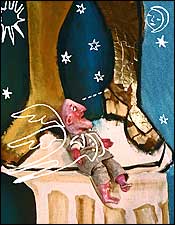
“As close as ballet has gotten to defying gravity, puppets really can,” says the choreographer David Neumann. “It can be a gorgeous device.” The “dancers” in his adaptation of Oscar Wilde’s The Happy Prince are part human and part paper, made by the acclaimed Amy Trompetter.
The story concerns a city’s late, beloved prince, who’s been memorialized with a statue in the town center. During his life, he was shielded from everyday concerns and wanted for nothing. “Now that I am dead they have set me up here so high that I can see all the ugliness and all the misery,” wrote Wilde in the voice of the statue, “and though my heart is made of lead yet I cannot choose but weep.” And he asks a bird to pluck the precious jewels from the statue and give them to the poor.
Trompetter’s known for playing with scale, and onstage, the statue is so large that it’s never seen in full; the empathetic bird has a ten-foot wingspan. “A lot of people imagine marionette-style puppets, but all of Amy’s puppets are fixed-figure papier-mâché,” says Neumann. So once he explains how he wants them to move, they’re in the hands of six puppeteers—“unsung heroes,” he says, “who can really make something come to life.”
The Happy Prince, at the Kitchen; September 23 through 25.